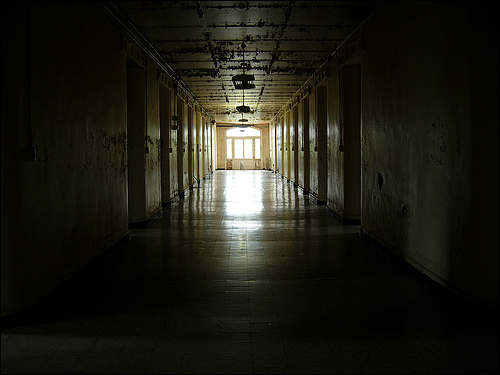
This article is part of our February theme, which focuses on one of the great silences in the human rights conversation in Australia: Prisoners’ Rights. Read our Editorial for more on this theme.
In January 2012, the Australian Government released the draft Ten Year Roadmap for National Mental Health Reform (the Roadmap). While its stated aim is for Australia to be a country that “maximises opportunities to prevent mental health problems and support people with mental illness… to live full and rewarding lives,” the Roadmap provides scant recognition of the high rates of people with a mental illness within correctional facilities. By failing to recognise and implement strategies to reduce these rates, the Roadmap neglects the mental health needs of the most vulnerable in the community.
Mental illness in Correctional facilities
The high rate of mental illness among prisoners is well documented. In 2009, the Australian Bureau of Statistics reported that 41 per cent of people who have been in prison had experienced mental illness, which is twice the prevalence of people who had not been in prison. More recently, the Australian Institute of Health and Welfare’s research report, The health of Australia’s prisoners 2010, recorded that 31 per cent of prison entrants had been told they had a mental health illness and 16 per cent of prison entrants reported they were currently taking medication for a mental health condition.
On entry to prison, almost one-fifth of prison entrants were referred to the prison mental health services for observation and further assessment. Young people in juvenile detention facilities also have high rates of mental illness. The 2011 report, NSW Young People in Custody Health Survey found that as many as 87 per cent of young people in custody had a psychological disorder of some description.
The Roadmap all but ignores the mental health needs of prisoners.
International human rights treaties (of which Australia is a signatory) provide rights to effective mental health treatments for those in correctional facilities. The United Nations Principles on the Protection of People with a Mental Illness and the Improvement of Mental Health Care provides that “all persons have the right to the best available mental health care” and that “all persons with a mental illness…shall be treated with humanity and respect”. The Principles expressly apply to people serving sentences of imprisonment “to the fullest extent possible, with only limited modifications and exceptions as are necessary in the circumstances”. The Standard Minimum Rules for the Treatment of Prisoners provides that “prisoners with other mental diseases or abnormalities shall be observed and treated in specialised institutions under medical management” and while in prison shall be placed under the “special supervision of [a] medical officer.”
Despite these treaties, the needs of people with a mental illness in prisons are overlooked. A report of the Special Rapporteur on the right of everyone to the enjoyment of the highest attainable standard of physical and mental health noted “current services are insufficient to treat the number of inmates who suffer from mental illness” and that “resourcing of mental health diagnosis and treatment within prisons, particularly for chronic illnesses, remains inadequate.” More recently the NSW Ombudsman’s Annual Report 2010-2011 raised concerns about Justice Health’s delay in providing medication to prisoners for mental health conditions.
In the decade to 2008 … 471 people died in Australian prison custody, an increase of nearly 50% from the decade to 1989.
The Roadmap and Mental illness
The Roadmap all but ignores the mental health needs of prisoners. The Roadmap provides a brief mention of the need for “better connections between health service agencies in the corrections and justice system” but provides no specific strategies to ensure that prisoner’s access to appropriate treatments is secured.
It is essential that the Roadmap provide a national focus to the issue of mental health in correctional facilities. The Roadmap should highlight current gaps in service delivery and commit to investigating the best ways to address those gaps. Because the provision of mental health services to prisoners is ultimately a state and territory responsibility, it is essential that the Commonwealth Government uses the Roadmap to ensure best practice solutions are implemented in nationally consistent policy responses.
Suicide prevention
Suicide prevention requires just such a national response. A large number of studies have highlighted the high level of suicide and self-harm in prisons. According to the Australian Institute of Criminology, which is responsible for compiling national statistics on deaths in custody, the number of prison deaths since 2006 has risen nationwide, despite the size of the Australian prison population remaining fairly stable. In the decade to 2008, the last year for which verifiable figures are available, 471 people died in Australian prison custody, an increase of nearly 50% from the decade to 1989. A review into the number of suicides in New South Wales prisons from 1 January 1995 to 31 December 2005, Suicide in New South Wales Prisons, 1995-2005: towards a better understanding, found a total of 92 cases were identified as deaths by suicide in this period. This represented 41 per cent of all deaths in custody for this period. Those on remand or serving a sentence of less than 6 months accounted for 64 per cent of all suicides in NSW custody, with 75 per cent occurring within six months of incarceration. This report also found the rate of suicide in prisons was ten times the level of death by suicide in the NSW community. A study conducted by Crikey for the period 2001-2009 found 59 deaths by suicides in NSW prisons.
[T]he Roadmap provides scant recognition of the high rates of people with a mental illness within correctional facilities.
In the absence of a nationally consistent approach, the kinds of treatment and support available to people at risk varies from state to state. In NSW, the current approach to the prevention of suicide in prison is through the use of “safe cells.” Safe cells are purpose-built prison cells designed to minimise the opportunity for prisoners to deliberately or accidently harm themselves. According to Crikey, safe cells are designed “to minimise the opportunities of self harm, so therefore it’s got no hanging points, they’ve got special blankets, it has camera observation and nothing sharp or unscrewable”. They are used for the involuntary seclusion of inmates who are considered at risk of self-harm.
There have been a number of concerns expressed about the use of safe cells in NSW. Often, prisoners at risk of suicide do not disclose their intent to suicide or self-harm in order to avoid placement in such cells. An additional concern is that being placed in such a cell actually increases the risk of suicide after a prisoner’s release. A range of alternative mechanisms are in place in other jurisdictions, including the use of “step-down” procedures in Victoria. These alternatives are effective in reducing rates of suicide and self-harm.
A nationally consistent approach, through the Roadmap, is necessary in order to ensure that best practice mechanisms are implemented across states and territories. It is also vital that the Roadmap recognises the impact of mental illness on vulnerable populations, including people within correctional facilities. While mental illness can and does impact members in every level of society, its effects are most acutely felt by those without the resources and means to access effective treatment and support.
Chris Hartley is a Senior Policy Officer with the Public Interest Advocacy Centre in Sydney (PIAC).


